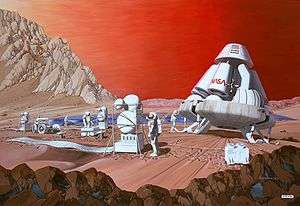Mars suit
.jpg)

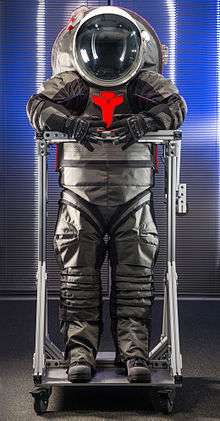

Mars suit or Mars space suit is a space suit for EVAs on the planet Mars.[4][5] Compared to space-walking in the near vacuum of low Earth orbit, Mars suits have a greater focus on actual walking and a need for abrasion resistance.[4] There is more gravity than a zero-G EVA, so weight is a bigger concern, but there are fewer thermal demands compared to open space.[6] At the surface the suits would contend with the atmosphere of Mars which has a pressure of about 0.6 to 1 kPa (6 to 10 millibars).[7] On the surface, radiation exposure is a concern especially solar flare events, which can dramatically increase the amount of radiation over a short time.
Some of the issues a Mars suit for surface operations would face include having enough oxygen for the person as the air is mostly carbon dioxide, in addition the air is also much lower pressure than Earth's atmosphere at sea level.[8] Other issue include the Martian dust, low temperatures, and radiation.[9]
Overview
One idea for a Mars suit from the 2010s on the NASA Z-2 suit, is to have electroluminescent patches to help crew-members identify one another.[10] Three types of tests planned for the Z-2 include tests in vacuum chamber, tests in NASA's Neutral Buoyancy Laboratory (a large pool for mimicking zero-g), and tests in rocky desert area.[11] (See also: Z series space suits)
The planned Mars 2020 rover has a materials test that is hoped will aid Mars suit development, the SHERLOC experiment; it includes a test target with space suit materials.[12] How these suit materials are effected by the Martian environment will be measured by the device.[12] Six materials have been chosen for being tested, Orthofabric, Teflon, nGimat-coated Teflon, Dacron, Vectran, and Polycarbonate.[13] The test will help select the best materials for future Mars space suits.[13] Orthofabric is a polymeric material composed of a weave of GORE-TEX fibers, Nomex, and Kevlar-29.[14]
NASA tested possible Mars space suit materials by exposing them to Mars equivalent UV radiation for 2500 hours, and then studied how the materials were effected.[15] One of the concerns for the Mars suits, is how materials respond to chemically reactive Mars dust and exposure to ultraviolet, especially over the lengths of time and amount of use the suits are expected to function.[16]
One researcher working on a design for Mars surface EVA suits was inspired in part by Medieval armor suits.[3] Some ideas for a Mars suits are a Heads-up display projected in the visor, built-in communications equipment, life support, and a voice-recognition assistant.[3]
Examples of design concerns:[3]
- High-speed winds filled with abrasive Mars dust.[3]
- Radiation such as cosmic rays[3]
- Low temperatures down to minus 130 degree Celsius.[3] (-202 Fahrenheit, 143 degrees Kelvin)
- Exposure to ultra-violet light[17]
One Mars mission design aspect, is if the Mars suits should also be made to work in space, or be for the surface only.[6]
Designs:[3]
The Biosuit is a mechanical counter-pressure suit, resulting in a body hugging form.[19] In this type of suit, the pressure would come from the structure and elasticity of the material, whereas with prior space-worn suits the pressure comes from pressurized gas, like a filled balloon.[20] The gas-pressure can make a flexible suit very rigid, like an inflated balloon.[20] (see also Space activity suit)
The ''Aoudo'' suit by the Austrian Space Forum space suit simulator for planetary surfaces.[21] The suit ventilates with ambient air, but has host of features to help simulate a space suit as well as tests enhancing technologies like a heads-up display inside the helmet.[22]
A simulated Mars suit was used for the HI-SEAS Earth-based spaceflight analog tests of the 2010s in Hawaii, USA.[23]
Mars suit design has been utilized as a topic for technology education.[24]
Mass and weight

The Apollo lunar surface EVA suit weighed 180 pounds on Earth, but only 30 pounds on the Moon.[25] The suit for Space Shuttle EVAs was used in micro-gravity so its weight was less of an issue: it weighed 310 pounds.[26]
In one study for Mars suits, they estimated a suit similar to Apollo lunar capabilities would need 45 kg of mass.[27]
| Earth | Moon | Mars | Notes | |
|---|---|---|---|---|
| Gravity (Earth) | 100% | 17% | 38% | |
| Apollo Lunar suit | 82 kg (180 lb) | 14 kg (30 lb) | 31 kg (68 lb) | |
| Shuttle EVA suit | 140 kg (310 lb) | 24 kg (52 lb) | 54 kg (118 lb) | |
| Ed White Spacewalk (G4C) | 15 kg (34 lb) | 2.5 kg (5.6 lb) | 5.9 kg (13 lb) | Need umbilical[28][29] |
Temperature
There can be large temperature swings on Mars; for example, at the equator, daytime temperature may reach 21 °C (70 °F) in the Martian summer, and drop down to −73 °C (−100 °F) at night.[30] According to a 1958 NASA report, long-term human comfort requires temperatures in the 4 to 35 °C (40 to 95 °F) range at 50% humidity.[31]
Examples of Mars surface temperatures:[30]
- Average: −62 °C (−80 °F)
- Polar locations in winter: −125 °C (−193 °F)
- Equator in summer, daytime high: 35 °C (95 °F)
Pressure

Atmospheric pressure on Mars averages 600 pascals (0.087 psi; 6.0 mbar) at the surface. The lower limit for human pressure needs is known as the Armstrong limit, and was discovered in the early 20th century, and necessitated the need for partial pressure suits on high-altitude flights.
The Armstrong limit is the pressure that water boils (vaporizes) in Earth air at the temperature of a human body, and is about 6.3 kpa (0.91 psi).[33] This does not correspond to the pressure humans do not get enough oxygen for normal breathing, which happens at a higher pressure although it depends on the gas mixture and other factors.[34] (See also breathing gas)
Because Mars has some atmosphere a suit does has some pressure on it from the outside, but one of the design questions is if the suits will also be used in Mars orbit in the vacuum of space, or just on the Mars surface. [6] Another consideration would be operations on a Martian moon, where there extremely low gravity. On the surface, there is a risk of puncture from Mars rocks, which are known to have damaged the wheels on Curiosity rover, and an additional need is to deal with dust storms. In orbit, there is greater exposure to radiation and lower gravity then on the surface of Mars.
The highest normal pressure on Mars is predicted to be on the bottom of Hellas Basin, the lowest elevation on the planet Mars, 12.4 millibars (about 0.18 psi or 1240 pascals).[35] The average pressure on Mars has been measured to be about 6.1 millibars (0.88 psi), and is composed primarily of carbon dioxide (95.3%), nitrogen (2.7 percent), argon (2%), and oxygen (0.13 percent).[36] There is a seasonal variation over the Martian year (about 2 Earth years) as carbon dioxide is sequentially frozen out of the atmosphere, then sublimated back into the atmosphere when its warmer causing a global 2 millibar (0.029 psi) rise and fall in pressure.[37] Carbon dioxide snow precipitating out the atmosphere is another environmental consideration.[38]
At 150 thousand feet of altitude (28 miles or 45 km) on Earth, the atmospheric pressure starts to be equivalent to the surface of Mars.[39] However, the major component of Mars air, CO2 gas, is denser than Earth air for a given pressure.[40]
Oxygen
To prevent hypoxia, getting too little oxygen, humans breathe Earth-style air within a certain range of pressures, and beyond that need supplemental oxygen.[41] Another danger to humans is hyperoxia, where they receive to much oxygen.[42]
To supply the right amount oxygen to a person at a lower pressure, it is possible to survive by increasing the ratio of Oxygen to other gases.[43] However, the amount of oxygen a person needs is somewhat variable because a larger amount of oxygen can be taken in for example by breathing faster, or through a biological process known as acclimatization.[44]
Oxygen makes 0.13 percent of the Martian atmosphere.[36]
Other considerations for breathing
Humans take in oxygen and expel carbon dioxide when they breathe, and typically breathe between 12 to 20 times per minute at rest but up 45 times per minute under high activity.[45] When breathing Earth air, breathe contain about 4 percent carbon dioxide and 16 percent oxygen, along with 78 percent nitrogen.[46] Exhaled air also contains trace amounts of 3,500 other chemical compounds as well as water vapor.[47] [46] In typical conditions are human will exhale about 0.2 to 0.3 liters of water.[47]

To maintaining breathable air in a closed system an important task is scrubbing (removing) carbon dioxide.[48] If nitrogen is used to increase pressure as on the ISS, it is inert to humans, but can cause the bends condition during decompression.[49] Space suits typically operate at low pressure to make their balloon like structure easier to move, so astronauts must spend a long time getting the nitrogen out of their system. The Apollo missions used a pure oxygen atmosphere in space except on the ground, to reduce risk of fire. There is also interest in hard suits that can handle higher internal pressures but be more flexible, so astronauts do not have to get the nitrogen out of their system before going on a spacewalk. Another consideration is if astronauts some how breathe in Mars dust.
The health effect of Mars dust is a concern, based on known information about it which includes that it may be abrasive and/or reactive.[50] Studies have been done with quartz dust and also compared to lunar dust exposure.[51] An Apollo 17 astronaut complained of a hay fever like symptoms after his moon walk.[52] The lunar dust was known to cling to the space space suits and taken in with the astronauts when they came in to the Apollo Lunar Module.[53]
A concept to scrub CO2 from breathing air is to use re-usable amine bead carbon dioxide scrubbers.[54] While one carbon dioxide scrubber filters the astronaut's air, the other can vent scrubbed CO2 to the Mars atmosphere, once that process is completed another one can be used, and the one that was used can take a break.[55] Another more traditional way to remove carbon dioxide from air is by a lithium hydroxide canister, however these need to be replaced periodically.[56] Carbon dioxide is produced by the human body and exhaled, however it slowly becomes more toxic in high concentrations if in the air being breathed in.[57] Carbon dioxide removal systems are standard part of habitable spacecraft designs, although there specifics varies.[58] One idea to remove carbon dioxide is to use a zeolite molecular sieve, and then later the CO2 can be removed from the material.[59]
Radiation
On Earth humans are exposed to about 0.6 rads per year, and aboard the International Space Station about 8 rads/ per year.[60] Over a lifetime humans tolerate about 200 rads of radiation, however any radiation exposure carries risk so there is a focusing on keeping exposure as low as possible.[61] On the surface of Mars there is two main types of radiation, a steady dose from a variety of sources and solar proton events which can cause a dramatic increase in the amount of radiation for a short time.[62] Solar flare events can cause a lethal dose to be delivered in hours if astronauts are caught unprotected, and this is a concern of NASA for human operations in space and on the surface of Mars.[63] Mars does not have a large magnetic field in the same way as Earth, which helps shield Earth from radiation especially solar flares.[64] A really famous solar event occurred on August 7, 1972 just 5 months after Apollo 16, and the solar event produced so much radiation, including a wave of accelerated particles like protons, that NASA became concerned what would happen if such an event were to occur while astronauts were in space.[65] If the astronauts get too much radiation, it tends to increase their lifetime cancer risk and they can get radiation poisoning.[66] Exposure to ionizing radiation can also cause cataracts, a problem with the eye.[67]
The atmosphere of Mars is much thinner than Earth, so it does not stop as much radiation.[68]
Toliet
A human consideration for suits is the need to go the bathroom.[69] Various methods have been employed in suits and in the Shuttle era NASA utilized maximum absorbency garments to enable stays of 10 hours in space and partial pressure suits.[70]
Use

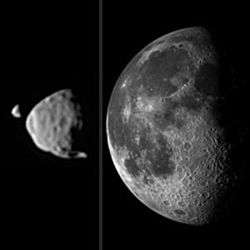
An article in the magazine Nature, noted that due the reduced gravity the dynamics of walking on Mars would be different than Earth.[71] This is due to aspect that people fall forward as part of their gait when moving.[71] Compared to the Earth, all else being equal it would be half-the amount of work to move, however a walking speed would be 3.4 km per hour rather 5.5 km per hour on Earth.[71] This data was produced by simulating Martian gravity for duration on an aircraft following a flight profile that causes this type of acceleration.[71] The acceleration of gravity at the surface of Mars is calculated to be about 3.7 meters per second2.[72] It is not known if this reduced gravity causes the same kind of reduced muscle mass and biological effects as living in micro-gravity as aboard ISS for several months.[72] The gravity is about 38% of Earth's gravity at the surface.[73]
Rock climbing tests with a low-pressure IVA (intra vehicle activity) suit were conducted in Oregon, USA.[74] The difficulty of grasping rock with gloves including moving fingers and gaining friction with rocks was noted, and the use of ice climbing axes noted in the test to help climb surfaces.[74] Mountaineering on Mars may be needed when the terrain environments exceeds the abilities of a rover vehicle, or to access a target of interest, or simply to get home to a base.[75] One common mountaineering need is a highly mobile short-stay shelter to use for over-night stays when climbing, such as tent, and an equivalent for Mars might support the ability to get out of a space suit.[75] Suit design for climbing would likely be impacted by the needs for climbing including suit flexibility, especially in the hands and also in terms of durability.[75]
Another issue is the expected amount of use for the suits in probably human mission designs.[76] For example, up to the late 2010s there was over 500 EVA's from the start of spaceflight, whereas a single mission to Mars is expected to need 1000 EVAs.[77]
Typical Mars mission plans note that a person wearing a Mars suit would need to enter a pressurized rover through an airlock.[78] Alternatively, a Mars suit would need be worn on manned unpressurized rovers to provide life support.[79] There is several different options for an egress and entry airlock for a space suit, and one of these is to repressurize the entire compartment as on the Apollo lunar lander.[80] Some other ideas are suitport, crewlock, and transit airlock.[81]
Need
The NASA Authorization Act of 2017 which included $19.5 billion USD in funding for that fiscal year, also directed NASA to get humans near or on the surface of Mars by the early 2030s.[82]
Suitport for Mars
Mars space suits have been explored for integration with airlock design that combines an airlock and suit entry and egress with another vehicle, and is commonly known as suitport.[83] This has been considered for a way to integrate a manned pressurized Mars rover with Mars space suit EVAs.[84]
The idea is that a person would slide into the suit through an airlock opening, while the exterior of suit was outside the vehicle and exposed to the Martian environment.[85] Then the hatch would be closed sealing off the interior of the vehicle, and the person would be supported by the suits life support system.[86] NASA tested the Z-1 space suit for extraterrestrial surface EVA with a suitport design in the 2010s.[87] In the NASA Z-1 design there is a hatch at the rear of the space suit which can be docked with a suitable vehicle or structure. [87]
Survey
Visions of Mars EVA
 Human Mars mission designs usually include Mars EVA suits, in this vision people in suits in combination with manned rovers and other equipment maneuver on the Martian surface. Mission enhancing technologies to give astronauts an edge are often explored, such as a wrist mounted video display of some kind in this case.
Human Mars mission designs usually include Mars EVA suits, in this vision people in suits in combination with manned rovers and other equipment maneuver on the Martian surface. Mission enhancing technologies to give astronauts an edge are often explored, such as a wrist mounted video display of some kind in this case. Artist's conception of a crew going on surface EVA on Mars, circa early 1960s. In the background is a Mars Excursion Module (MEM)
Artist's conception of a crew going on surface EVA on Mars, circa early 1960s. In the background is a Mars Excursion Module (MEM) Staged photosimulation art of martian space suit on EVA (NASA, 2010s)
Staged photosimulation art of martian space suit on EVA (NASA, 2010s) Rock climbing on Mars
Rock climbing on Mars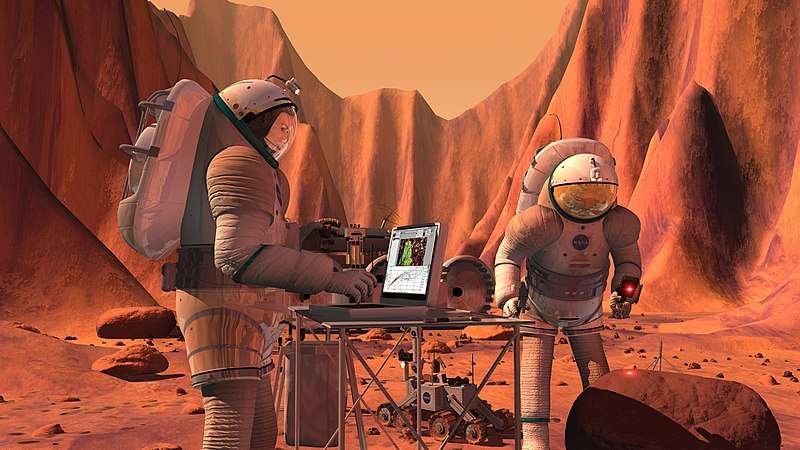 NASA concept of Mars-crew analyzing a sample (2004).[88]
NASA concept of Mars-crew analyzing a sample (2004).[88] The first human Mars explorers survey Valles Marineris at sunrise (1989)
The first human Mars explorers survey Valles Marineris at sunrise (1989)
Designs
The AX-5 was part of line of Hard-suits developed at NASA Ames. Current suits use a lower-pressure pure oxygen atmosphere, which means people going on EVA must pre-breathe oxygen to avoid getting decompression sickness.
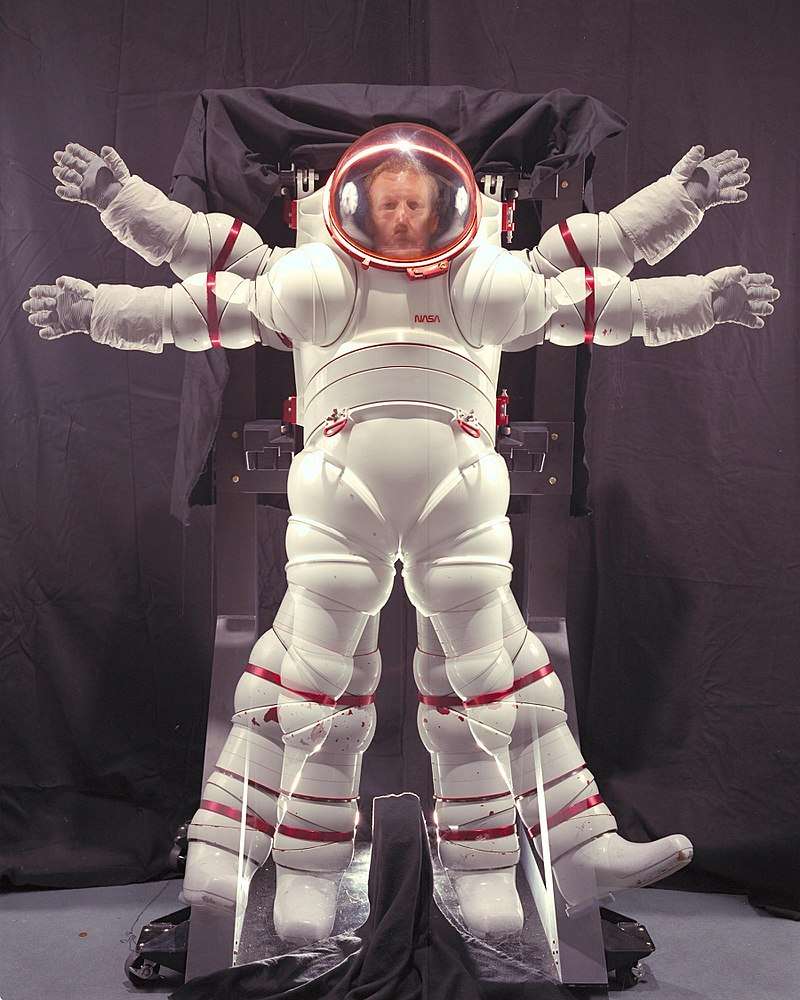
See also
- Manned Mars rover
- Mars habitat
- List of missions to Mars
- Thermal Micrometeoroid Garment
- Extravehicular activity
- Suitport
- Beta cloth
- Single-person spacecraft
- ILC Dover (Company that has made Apollo, Shuttle, ISS, etc. space suits for NASA)
- Kuratas
- Locomotion in space
External links
| Wikimedia Commons has media related to Mars suit. |
Further reading
- History of Space Suits (1994, NASA)
- Suiting Up for the Red Planet - IEEE (September 2015)
References
- ↑
- 1 2 "New Mars space suit unveiled by NASA - Technology & Science - CBC News". cbc.ca. Retrieved 2018-02-24.
- 1 2 3 4 5 6 7 8 "Climbing inside Aouda.X: The spacesuit made to walk on Mars". CNN. Retrieved 2018-02-25.
- 1 2 "This is NASA's latest space suit design for Mars". CBC News. Retrieved 2018-02-24.
- ↑ "Mars Suit - The Technology - Mars One". Mars One. Retrieved 2018-02-24.
- 1 2 3 Genta, Giancarlo (2016-12-30). Next Stop Mars: The Why, How, and When of Human Missions. Springer. ISBN 9783319443119.
- ↑ Elert, Glenn. "Pressure on the Surface of Mars - The Physics Factbook". hypertextbook.com. Retrieved 2018-02-25.
- ↑ "Boiling Blood and Radiation: 5 Ways Mars Can Kill". Space.com. Retrieved 2018-09-11.
- ↑ "Boiling Blood and Radiation: 5 Ways Mars Can Kill". Space.com. Retrieved 2018-09-11.
- ↑ "This is NASA's latest space suit design for Mars | CBC News". CBC. Retrieved 2018-02-24.
- ↑ Roberts, Jason (2015-08-17). "NASA's Next Prototype Spacesuit Has a Brand New Look". NASA. Retrieved 2018-02-25.
- 1 2 "The next NASA rover could lead to safer space suits for astronauts exploring Mars". mercurynews.com. Retrieved 2018-02-24.
- 1 2 "Experimenting, Testing of Safer Space Suit Materials will Be Conducted on JPL's 2020 Mars Rover Mission". Pasadena Now. Retrieved 2018-02-24.
- ↑ William Lewis Miller (November 1985). "Mass Loss of Shuttle Space Suit Orthofabric Under Simulated Ionospheric Atomic Oxygen Bombardment" (PDF). NASA Technical Memorandum 87149. Retrieved 2018-02-25.
- ↑ "The next NASA rover could lead to safer space suits for astronauts exploring Mars". The Mercury News. 2018-02-20. Retrieved 2018-02-24.
- ↑ "Here's What Spacesuits for Travel to Mars Might Look Like". Racked. Retrieved 2018-09-10.
- ↑ Kristine Larson; Marc Fries (2017-02-27). "Ultraviolet Testing of Space Suit Materials for Mars" (PDF). 47th International Conference on Environmental Systems. Retrieved 2018-02-25.
- ↑ "Biosuit". MVL. Retrieved 2018-02-25.
- ↑ "Biosuit | MVL". mvl.mit.edu. Retrieved 2018-02-24.
- 1 2
- ↑
- ↑ esa. "Aouda.X, spacesuit simulator for planetary surface exploration". European Space Agency. Retrieved 2018-02-28.
- ↑ "NASA's Mars simulation space suit just got a redesign". Retrieved 2018-02-24.
- ↑ "Designing Spacesuits for Mars". NASA. Retrieved 2018-02-25.
- 1 2 History of Space Suits
- ↑
- ↑ Carr, C. E. (2016-3). Optimal space suit mass for Mars extravehicular activity. 2016 IEEE Aerospace Conference. pp. 1–10. doi:10.1109/AERO.2016.7500869. ISBN 978-1-4673-7676-1. Check date values in:
|date=(help) - ↑
- ↑ Kenneth S. Thomas & Harold J. McMann (2006). US Spacesuits. Chichester, UK: Praxis Publishing Ltd. ISBN 978-0-387-27919-0.
- 1 2
- ↑
- ↑ "S86-25375 (1986)". Spaceflight.nasa.gov. Retrieved 4 August 2014.
- ↑ "What is the Armstrong Limit?". WorldAtlas. Retrieved 2018-09-10.
- ↑ "What is the Armstrong Limit?". WorldAtlas. Retrieved 2018-09-10.
- ↑ "Making a Splash on Mars | Science Mission Directorate". science.nasa.gov. Retrieved 2018-09-11.
- 1 2 "How Mars Works". HowStuffWorks. 2000-11-06. Retrieved 2018-09-11.
- ↑ "How Mars Works". HowStuffWorks. 2000-11-06. Retrieved 2018-09-11.
- ↑ "How Mars Works". HowStuffWorks. 2000-11-06. Retrieved 2018-09-11.
- ↑
- ↑ Oliver Morton – MarsAir How to build the first extraterrestrial airplane. – NASA Quest
- ↑
- ↑ Mach, William J.; Thimmesch, Amanda R.; Pierce, J. Thomas; Pierce, Janet D. (2011). "Consequences of Hyperoxia and the Toxicity of Oxygen in the Lung". Nursing Research and Practice. 2011: 1–7. doi:10.1155/2011/260482. ISSN 2090-1429. PMC 3169834. PMID 21994818.
- ↑
- ↑
- ↑ "Diagram of the Human Respiratory System (Infographic)". Live Science. Retrieved 2018-09-12.
- 1 2 "The Chemical Composition of Exhaled Air From Human Lungs". Sciencing. Retrieved 2018-09-12.
- 1 2 Respiratory Humidification: Basics
- ↑
- ↑
- ↑ "Martian dust may be hazardous to your health". New Scientist. Retrieved 2018-09-10.
- ↑ "Martian dust may be hazardous to your health". New Scientist. Retrieved 2018-09-10.
- ↑ "Martian dust may be hazardous to your health". New Scientist. Retrieved 2018-09-10.
- ↑
- ↑ "Suiting Up for the Red Planet". IEEE Spectrum: Technology, Engineering, and Science News. Retrieved 2018-09-10.
- ↑ Courtland, Rachel (2015-09-30). "Suiting Up for the Red Planet - IEEE Spectrum". Spectrum.ieee.org. Retrieved 2015-11-08.
- ↑
- ↑
- ↑
- ↑ NASA- Closing the Loop: Recycling Water and Air in Space - Page 2 of 7
- ↑
- ↑
- ↑
- ↑
- ↑
- ↑
- ↑
- ↑ Chodick, Gabriel; Bekiroglu, Nural; Hauptmann, Michael; Alexander, Bruce H.; Freedman, D. Michal; Doody, Michele Morin; Cheung, Li C.; Simon, Steven L.; Weinstock, Robert M. (2008-09-15). "Risk of Cataract after Exposure to Low Doses of Ionizing Radiation: A 20-Year Prospective Cohort Study among US Radiologic Technologists". American Journal of Epidemiology. 168 (6): 620–631. doi:10.1093/aje/kwn171. ISSN 0002-9262. PMC 2727195. PMID 18664497.
- ↑ Garner, Rob (2015-09-30). "How to Protect Astronauts from Space Radiation on Mars". NASA. Retrieved 2018-09-10.
- ↑ "NASA's New Spacesuit Has a Built-In Toilet". Space.com. Retrieved 2018-09-10.
- ↑ "NASA's New Spacesuit Has a Built-In Toilet". Space.com. Retrieved 2018-09-10.
- 1 2 3 4 Cavagna, G. A.; Willems, P. A.; Heglund, N. C. (June 1998). "Walking on Mars". Nature. 393 (6686): 636. doi:10.1038/31374. ISSN 0028-0836. PMID 9641676.
- 1 2 "How Strong is the Gravity on Mars? - Universe Today". Universe Today. 2016-12-16. Retrieved 2018-05-11.
- ↑ "Ask an Astronomer". Cool Cosmos. Retrieved 2018-05-11.
- 1 2 "Rock Climbing on Mars: A Simulation". Climbing Magazine. Retrieved 2018-08-09.
- 1 2 3 "Mountaineering and Climbing on Mars | SpaceRef - Your Space Reference". www.spaceref.com. Retrieved 2018-09-15.
- ↑ "This Spacesuit for Exploring Mars Is a Form-Fitting Math Problem". WIRED. Retrieved 2018-09-10.
- ↑ "This Spacesuit for Exploring Mars Is a Form-Fitting Math Problem". WIRED. Retrieved 2018-09-10.
- ↑ Cohen, Marc (2000-08-01). "Pressurized Rover Airlocks": 776–5760. doi:10.4271/2000-01-2389.
- ↑
- ↑ Cohen, Marc (2000-08-01). "Pressurized Rover Airlocks": 776–5760. doi:10.4271/2000-01-2389.
- ↑ Cohen, Marc (2000-08-01). "Pressurized Rover Airlocks": 776–5760. doi:10.4271/2000-01-2389.
- ↑ "US Government Issues NASA Demand, 'Get Humans to Mars By 2033'". Futurism. 2017-03-09. Retrieved 2018-02-16.
- ↑ Cohen, Marc (2000-08-01). "Pressurized Rover Airlocks": 776–5760. doi:10.4271/2000-01-2389.
- ↑ Cohen, Marc (2000-08-01). "Pressurized Rover Airlocks": 776–5760. doi:10.4271/2000-01-2389.
- ↑ "Smart clothing on Mars: Spacesuits and Biosensitive Style". SKIIN. 2018-02-05. Retrieved 2018-09-17.
- ↑ "Smart clothing on Mars: Spacesuits and Biosensitive Style". SKIIN. 2018-02-05. Retrieved 2018-09-17.
- 1 2 "Introducing NASA'S Future Spacesuit, the Z-1 (Infographic)". Space.com. Retrieved 2018-09-17.
- ↑
